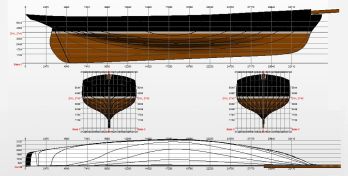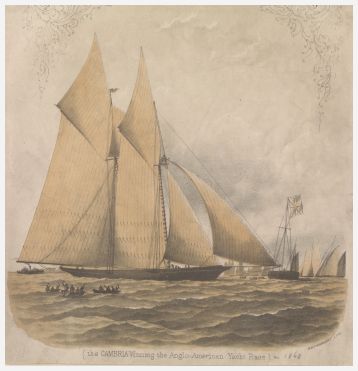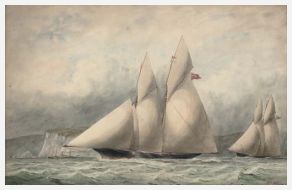Yves GARY Affichages : 5126
Catégorie : CAMBRIA
 SCIENTIFIC AMERICAN - MAY 21, 1870 (pas de traduction)
SCIENTIFIC AMERICAN - MAY 21, 1870 (pas de traduction)The Cambria, schooner, 248 tons, New York Yacht Club measurement, and probably the fleetest of the British yachts, was launched in May, 1868. She is a fine type of the deep and narrow English model, and in external appearance bears a resemblance to the stiffness and stability of a Cunard steamer.
Her dimensions are:
| CAMBRIA | |
| Feet. | |
| Length (from stempost to sternpost) | 108 |
| Beam | 21 |
| Depth of hold | 11 |
| Draft of water | 12 |
| Mainmast (hounds to deck) | 61 |
| Foremast | 56'6 |
| Foremast | 91'2 |
| Main boom | 61 |
| Main gaff | 33'9 |
| Fore gaff | 25 |
| Bowsprit (outboard stem) | 35 |
| Maintopsail | 35'6 |
| Foretopsail | 32'3 |
| Maintopllail yard | 32 |
| Foretopsail yard | 29 |
It can hardly be said that the Cambria is as graceful and charming in her pose upon the water as the majority of American schooners, and this is simply because the English are willing to sacrifice anything to secure the full embodiment of their ideas as to speed.
She is a keel schooner, substantially built of oak, with teak topsides. Her interior fittings are remarkably beautiful, rich, and in good taste, and the wainscoting is finished in polished oak. On the principle upon which she was built the Cambria is a most perfect triumph, and no one need doubt that she is the finest schooner in Great Britain. All of the delicate niceties employed by English yachtsmen in ballasting, sparring, and canvassing, have been tested by Mr. Ashbury, who, with a spirit which does credit to the most fascinating of all pastimes, has done much to develop yachting among his own countrymen to its present high status.
The Cambria has 21 tons of ballast smelted and run into her timbers, and she has also four tons of lead bolted to her keel. Under sail she spreads a vast area of canvas, and works in the wind with the ease and facility of a weather vane. It is by her qualities of being sharp and quick in stays, of being close to the wind, of making good time in light airs that yachtsmen claim that she is one of the fastest schooners in the world. By the wind, that is close-hauled, she has gaff topsails bent to the ordinary spars; but in sailing free she has much longer and lighter and more flexible yards aloft, and the sail of lighter canvas, of course, clubs out a considerable distance. Her bowsprit is a very peculiar spar, and with the jib boom and flying jib boom is all in one stick and rigs in and out at the option of the sailing master. Of course it is ugly in appearance, but the nautical advantages claimed for it are many and doubtless well founded.
 The Cambria has had a brilliant and eventful history. She has been the victor in many contests, and her bold and gallant owner and commander has sailed her in most all the seas that wash European shores, and has but recently returned from his cruise up the Mediterranean. She first won fame upon June 2, 1868, when she came in first, with the Egeria and Fleur de Lis as competitors; but in this contest she failed to win the prize because she had to give time allowance. She also figured with evidences of the finest qualities on the 17th of June, 1868; on the 30th of June, 1868; on the 6th of August, 1868 ; and on the 11th of August, 1868.
The Cambria has had a brilliant and eventful history. She has been the victor in many contests, and her bold and gallant owner and commander has sailed her in most all the seas that wash European shores, and has but recently returned from his cruise up the Mediterranean. She first won fame upon June 2, 1868, when she came in first, with the Egeria and Fleur de Lis as competitors; but in this contest she failed to win the prize because she had to give time allowance. She also figured with evidences of the finest qualities on the 17th of June, 1868; on the 30th of June, 1868; on the 6th of August, 1868 ; and on the 11th of August, 1868.
From the fattest part of the bilge the schooner's sides hollow with considerable concavity, and terminate in a rocker keel, 36 inches deep. She has a very fine and light stern, peculiar to herself, and is quite hollow aft. Her stern is all dead wood and drags no water, leaving a narrow wake. She stands up well, is remarkably quick in stays, is well sparred, and nearly as strong as crystallized rock: built of oak, locust, and hackmatack; finished on the interior with a hard wood cabin, and in every respect a graceful and elegant craft. She has few superiors or equals.
On the 26th of August, 1869, she beat the Sappho, her competitor yesterday, and in the same race,  three fast English yachts, the Aline, Oimara, and Condor.
three fast English yachts, the Aline, Oimara, and Condor.
After these victories alterations were made in the Cambria to make her more sea-worthy. She was padded forward, her masts were bored, and the weight of her keel was diminished. Besides, on the occasions named, the Cambria has won golden laurels, especially upon beating to windward, in a trial of this quality with an English cutter (corresponding to our American sloop), in which she was again the victor. This is her forte. During the present season the Cambria has been given more ballast, her bulwarks have been raised forward and her scuppers have been much enlarged. She is now, according to the dispatches in her best trim, and she will have every American and English eye bearing upon her during the season of 1870.
